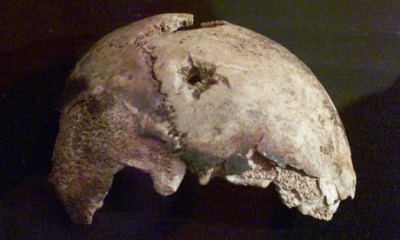.
.
The surrender of Berlin
|
|
|
|
Some of the SS personnel, who did not join any of the breakout groups, opted to commit suicide. General Hans Krebs, Deputy Chief of the Army General Staff, and General Wilhelm Burgdorf, the Chief Adjutant to Adolf Hitler, along with SS-Obersturmbannführer (Lieutenant Colonel) Franz Schädle of the SS-Begleitkommando des Führers, stayed behind.
Since the field hospital in the Reich Chancellery above needed power and water, Johannes Hentschel, the master electro-mechanic for the bunker complex, opted to stay even after everyone else had either left or committed suicide.

At 6 am, on May 2, 1945, General Helmuth Weidling, the commander of the Berlin Defense Area, unconditionally surrendered the city to General Vasily Chuikov, the commander of the Soviet 8th Guards Army.
Around 9 am,, the first Russian combat troops arrived at the bunker complex unopposed. They were followed by the Russian search teams of “SMERSH”, equivalent of CIC of the Allieds.
SMERSH (acronym of Spetsyalnye MEtody Razoblacheniya SHpyonov or Special Methods of Spy Detection, but also referred to as SMERt‘ SHpionam; “Death to spies”) was an umbrella name for three independent counterintelligence agencies in the Red Army formed in late 1942 or even earlier, but officially founded on April 14, 1943.
The Narodnyy Komissariat Vnutrennikh Del (The People’s Commissariat for Internal Affairs) abbreviated НКВД (NKVD) soldiers captured more than 50 officers and men who were still there in the bunker complex, including Johannes Hentschel. Then they found out that the bulk of the Reich Chancellery group had decamped during the night.
Lieutenant Colonel Ivan Klimenko, the leader of one of the search teams found the cadaverous remains of the partly burnt corpses of the Goebbels and filmed them. He immediately sent the remains to the Russians headquarters in Berlin’s Plötzensee Prison.
Hitler’s Double
Another search team found an old oak water tank which contained many dead bodies. They pulled out a particular body that resembled Hitler.

The dead man was one of Hitler’s doubles, named Gustav Weler. The Russians mistakenly believed the body to be that of Hitler because of his identical moustache and haircut. They photographed and filmed the dead body of was Weler.
The security personnel in the bunker, responsible for Hitler’s safety, may have had Gustav Weler, a doppelgänger or Body-double of Adolf Hitler, to camouflage and help Hitler escape, if Hitler decided to take part in a breakout. But, after Hitler’s death, they would have realized that any double if found would be an embarrassment, and therefore disposed him by shooting in the forehead, in an attempt to confuse the Russian troops.
Gustav Weler’s body was taken to Lefortovo prison in Moscow, for further investigations, and was laid to rest in its yard.
When Ivan Klimenko returned to the bunker the next day, May 3, 1945, he found the body resembling Hitler, displayed prominently in the main hall of the Reich Chancellery. Ignoring the darned socks, worn by the dead man, Klimenko assumed the crucial problem of finding Hitler dead or alive had been solved.
Then probing inside the darkened bunker the Russians found the bodies of many Germans who had committed suicide, including that of General Hans Krebs. The bodies of General Wilhelm Burgdorf and SS-Obersturmbannführer Franz Schädle were never found.

The Russians then discovered the bodies of the six Goebbels children lying in their beds in the Vorbunker. They were wearing white nightclothes with the clear mark of cyanide shown on their faces. According to the autopsy the Russians carried out, bruising on the face of 12-year-old Helga Goebbels indicated that she was forced to ingest cyanide.
Finding Hitler’s body
On the following day, May 4, 1945, Ivan Churakov, a Russian soldier, climbed into a nearby bomb crater strewn with burned paper. He saw some partly burnt furry object and he hollered, “Comrade Lieutenant Colonel, there are legs here.“
They started to dig and pulled from the crater two dead dogs, and digging further they found the burnt bodies of a man and a woman. At first Klimenko did not even think that the two burnt corpses might be that of Adolf Hitler and Eva Braun. Since he believed that Hitler’s corpse was already displayed prominently in the Chancellery and only needed to be positively identified, he therefore ordered the newly discovered burnt cadavers to be wrapped in blankets and reburied.
On Saturday, May 5, 1945, Comrade Klimenko while pondering over his finding the burnt bodies of a man and a woman from the burnt crater rushed back and exhumed the two bodies. He transported both bodies to Plötzensee Prison. There he was ordered to send them on to the 496th Field Hospital in Buch, a German locality within the Berlin borough of Pankow.
On May 8, 1945, the Victory in Europe Day (V-E Day), the first preliminary forensic autopsy was performed on both bodies. Positive identification took place in a very simple yet quite foolproof.
A few days later, the Russians moved Hitler’s body to a different gravesite outside Berlin. This would be just one of several moves the corpse would make in the next few decades.
In early June 1945, the Russians re-buried the body of dead male identified as that of Hitler, in a forest near the town of Rathenau. Eight months later, they moved it again, to the SMERSH facility in the Soviet Army garrison in Magdeburg on February 21, 1946.
Soviet leaders were quite worried about leaving Hitler’s body in the garrison or burying it somewhere away from their watchful eye. They feared Hitler’s gravesite would eventually turn into a shrine for neo-Nazis.
Hitler’s body remained in Magdeburg until March 1970, when the Soviets decided to abandon the garrison and turn it over to the East German civilian government.
KGB director Yuri Andropov decided that Hitler’s remains should be destroyed. He authorized an operation to dispose the body. The KGB kept the fragments of a jawbone and skull, and stored it in government buildings in Moscow.
Yuri Andropov selected a KGB officer Vladimir Gumenyuk to pick a secret final resting place for Hitler’s remains. Armed with a secret coordinate to the last burial spot in the Soviet Army garrison in Magdeburg, Gumenyuk led a three-man team to dig out the remains and take them away for destruction.
Since the Soviet garrison was surrounded by German-built high-rise buildings in Magdeburg, to avoid being seen, Gumenyuk’s men pitched a tent over the spot where the bones had been buried. After some digging with no results, the team realized they had counted 45 meters instead of 45 paces while following the directions to the corpse. They put the dirt back, and moved the tent to the correct spot measuring in paces.
After securing the remains, Gumenyuk’s team disguised themselves as fishermen and drove to the mountains. They stopped along a small stream. There, they lit two campfires. One to make soup and the other to burn the remains further and turn them to ashes.

On September 26, 2009, the History Channel aired a documentary called Hitler’s Escape. For the making of the film, Connecticut archaeologist and bone specialist Nick Bellantoni flew to Moscow to inspect the Hitler trophies at the Russian State Archive which included the skull fragment with a bullet hole through it, which the Russians dug up outside the Führerbunker in 1946, as well as bloodstains from the bunker sofa on which Adolf Hitler and Eva Braun were believed to have committed suicide. The Russian government has been publicly claiming since 2000 that these articles belonged to Hitler.
Bellatoni said:
“I had the reference photos the Soviets took of the sofa in 1945 and I was seeing the exact same stains on the fragments of wood and fabric in front of me, so I knew I was working with the real thing.” (sic)
Examination of the skull by Bellantoni revealed it belonged to a young woman and not that of the 56-year-old dictator. “The bone seemed very thin. Male bone tends to be more robust,” he said. “And the sutures where the skull plates come together seemed to correspond to someone under 40.”
Bellantoni applied cotton swabs and took samples for DNA tests during the one hour he was allowed with the Hitler trove. The swabs were then flown back to Connecticut. At the university’s Centre for Applied Genetics, Linda Strausbaugh, worked for three days on the samples sent by Bellatoni. “We used the same routines and controls that would have been used in a crime lab,” she said.
The DNA analysis revealed that the skull undoubtedly belonged to a female, and the only positive physical proof that Hitler had shot himself had suddenly been rendered worthless. The result of the DNA analysis reopened the mystery surrounding Hitler’s death.
If Hitler allegedly shot himself in the right temple, then why did the Russians exhibit what is claimed to be Hitler’s cranium, showing a bullet hole in the back of his head?
Russian officials, however, rejected the findings of Nick Bellantoni.
.
.
RELATED ARTICLES
- Death of Adolf Hitler – Prelude (tvaraj.com)
- Death of Adolf Hitler – Part 1: The Reichskanzlei-Führerbunker (tvaraj.com)
- Death of Adolf Hitler – Part 2: Hitler retreats to the Reichskanzlei-Führerbunker (tvaraj.com)
- Death of Adolf Hitler – Part 3: Life in the Reichskanzlei-Führerbunker (tvaraj.com)
- Death of Adolf Hitler – Part 4: The Doubts About Loyalty to the Führer (tvaraj.com)
- Death of Adolf Hitler – Part 5: Hitler’s Marriage and Last Testaments (tvaraj.com)
- Death of Adolf Hitler – Part 6: Preamble to Suicide (tvaraj.com)
- Death of Adolf Hitler – Part 7: Suicide of Hitler and Eva Braun (tvaraj.com)
- Death of Adolf Hitler – Part 8: Burning the Bodies of Hitler and Eva Braun
(tvaraj.com) - Death of Adolf Hitler – Part 9: Suicide of Joseph Goebbels and His Wife (tvaraj.com)
- Death of Adolf Hitler – Part 10: Announcement of Hitler’s death to the outside world
(tvaraj.com) - Death of Adolf Hitler – Part 11: The Breakout from the Reichskanzlei-Führerbunker
(tvaraj.com) - Death of Adolf Hitler – Part 12: The Breakout by Martin Bormann
(tvaraj.com) - Death of Adolf Hitler – Part 14: The Fate of the Three Messengers
(tvaraj.com) - Death of Adolf Hitler – Appendix A: Adolf Hitler’s Private Testament (tvaraj.com)
- Death of Adolf Hitler – Appendix B: Adolf Hitler’s Last Political Testament (tvaraj.com)
- Death of Adolf Hitler – Appendix C: Marriage Certificate of Adolf Hitler and Eva Braun (tvaraj.com)\
- Helmuth Weidling (en.wikipedia.org)
- Wilhelm Mohnke ((en.wikipedia.org)
- Martin Bormann (en.wikipedia.org)
- Ludwig Stumpfegger (en.wikipedia.org)
- Artur Axmann (en.wikipedia.org)
- Hans Krebs (Wehrmacht general) (en.wikipedia.org)
- Wilhelm Burgdorf (en.wikipedia.org)
- Franz Schädle (en.wikipedia.org)
- Georg Betz (en.wikipedia.org)
- Armin D. Lehmann (en.wikipedia.org





15 thoughts on “Death of Adolf Hitler – Part 13: What Happened to Hitler’s Body?”